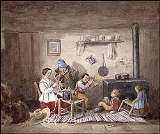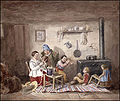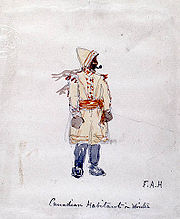
Habitants
Encyclopedia

Habitants is the name used to refer to both the French
French people
The French are a nation that share a common French culture and speak the French language as a mother tongue. Historically, the French population are descended from peoples of Celtic, Latin and Germanic origin, and are today a mixture of several ethnic groups...
settlers and the inhabitants of French
France
The French Republic , The French Republic , The French Republic , (commonly known as France , is a unitary semi-presidential republic in Western Europe with several overseas territories and islands located on other continents and in the Indian, Pacific, and Atlantic oceans. Metropolitan France...
origin who farmed the land along the two shores of the St. Lawrence Gulf and River in what is the present-day Province of Quebec in Canada
Canada
Canada is a North American country consisting of ten provinces and three territories. Located in the northern part of the continent, it extends from the Atlantic Ocean in the east to the Pacific Ocean in the west, and northward into the Arctic Ocean...
. The term was used by the inhabitants themselves and the other classes of French Canadian society from the 17th century up until the early 20th century when the usage of the word declined in favour of the more modern agriculteur (farmer) or producteur agricole (agricultural producer). The Habitants lived on the seigneur's property paying him with food as rent.
Unwilling to accept subordination to anyone but the Governor of New France
Governor of New France
The Governor of New France was the viceroy of the King of France in North America. A French noble, he was appointed to govern the colonies of New France, which included Canada, Acadia and Louisiana. The residence of the Governor was at the Château St-Louis in the capital of Quebec City...
himself, the inhabitants refused to be called censitaire, a designation they judged equivalent to paysan, who were the servile peasants in France's feudal system.
After the Canadian Confederation
Canadian Confederation
Canadian Confederation was the process by which the federal Dominion of Canada was formed on July 1, 1867. On that day, three British colonies were formed into four Canadian provinces...
in 1867, the seigneural system gradually ceased to exist. The industrialization of Quebec was another factor in the evolution of Quebec's working class, which eventually began migrating to cities like Montreal
Montreal
Montreal is a city in Canada. It is the largest city in the province of Quebec, the second-largest city in Canada and the seventh largest in North America...
and Quebec
Quebec City
Quebec , also Québec, Quebec City or Québec City is the capital of the Canadian province of Quebec and is located within the Capitale-Nationale region. It is the second most populous city in Quebec after Montreal, which is about to the southwest...
.
The plural was spelled Habitans before the spelling reform and until the spelling reform was accepted in Quebec in the 19th century. The singular word Habitant stayed the same.
The name "Habs", from the French "Les Habitants", is now used by English speaking fans as a nickname for the Montreal Canadiens
Montreal Canadiens
The Montreal Canadiens are a professional ice hockey team based in Montreal, Quebec, Canada. They are members of the Northeast Division of the Eastern Conference of the National Hockey League . The club is officially known as ...
ice hockey team; one of their many cheers is "Go Habs Go".
An illustration of a habitant appears on the flag of the Mouvement de libération nationale du Québec
Mouvement de Libération Nationale du Québec
The Mouvement de libération nationale du Québec is a secessionist group in Quebec, Canada, founded by Front de libération du Québec founder and convicted manslaughterer, Raymond Villeneuve...
.

In underpopulated New France the habitants welcomed the fact that the seigneur was obligated to build a mill. They had no military duties to perform except for their common defence against the Indians. There was little money and not much use for it; and so the taxes took the form of payments in chickens, geese, or other farm products. These obligations were hardly burdensome. The seigneurs were anxious that their habitants should wish to remain farmers, and there was as much land as anyone could till. They took over the company of 100 associates.

